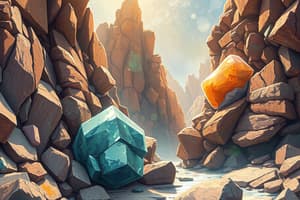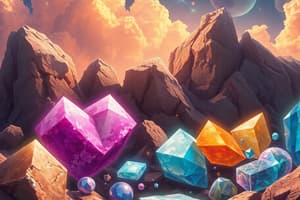Podcast
Questions and Answers
Feldspars are characterized by their triclinic crystal structure and are often found in various rock types.### ______ is a mineral that is widely found and geologically important
Feldspars are characterized by their triclinic crystal structure and are often found in various rock types.### ______ is a mineral that is widely found and geologically important
Biotite
Quartz is known for its hardness, resistance to weathering, and wide range of colors and crystal forms. It is a silicon dioxide mineral (SiO2) and is one of the most common minerals in the Earth's crust. It is often found in igneous, sedimentary, and ___________ rocks.
Quartz is known for its hardness, resistance to weathering, and wide range of colors and crystal forms. It is a silicon dioxide mineral (SiO2) and is one of the most common minerals in the Earth's crust. It is often found in igneous, sedimentary, and ___________ rocks.
metamorphic
Biotite is composed of silicon, aluminum, oxygen, and magnesium or iron. It is characterized by its platy crystal structure and is often found in dark-colored rocks.### ______ is a group of minerals that are characterized by their hardness and wide range of colors
Biotite is composed of silicon, aluminum, oxygen, and magnesium or iron. It is characterized by its platy crystal structure and is often found in dark-colored rocks.### ______ is a group of minerals that are characterized by their hardness and wide range of colors
Garnet
Feldspars are a group of rock-forming minerals that make up a significant portion of the Earth's crust. The most common types of feldspars are orthoclase, plagioclase, and ___________.
Feldspars are a group of rock-forming minerals that make up a significant portion of the Earth's crust. The most common types of feldspars are orthoclase, plagioclase, and ___________.
Garnets are composed of silicon, aluminum, oxygen, and various other elements, such as calcium, aluminum, and iron. They are known for their cubic crystal structure and can be found in various colors, with red being the most common.### ______ is a mineral that is commonly found in sedimentary and metamorphic rocks
Garnets are composed of silicon, aluminum, oxygen, and various other elements, such as calcium, aluminum, and iron. They are known for their cubic crystal structure and can be found in various colors, with red being the most common.### ______ is a mineral that is commonly found in sedimentary and metamorphic rocks
Calcite is often found in various types of rocks, including limestone, marble, and dolostone. It is characterized by its trigonal crystal structure and is often found in white, gray, or brown colors.### ______ is a mineral that is commonly found in igneous rocks, particularly basalt and gabbro
Calcite is often found in various types of rocks, including limestone, marble, and dolostone. It is characterized by its trigonal crystal structure and is often found in white, gray, or brown colors.### ______ is a mineral that is commonly found in igneous rocks, particularly basalt and gabbro
___________ is one of the most abundant minerals on Earth and is a major component of many rocks, including granite, quartzite, and sandstone.
___________ is one of the most abundant minerals on Earth and is a major component of many rocks, including granite, quartzite, and sandstone.
Muscovite is composed of aluminum, silicon, oxygen, and potassium and is often found in light-colored rocks, such as granite and gneiss. It is known for its white, gray, or green colors and is often used as an indicator mineral in geological studies.### ______ is a mineral that is commonly found in igneous and metamorphic rocks
Muscovite is composed of aluminum, silicon, oxygen, and potassium and is often found in light-colored rocks, such as granite and gneiss. It is known for its white, gray, or green colors and is often used as an indicator mineral in geological studies.### ______ is a mineral that is commonly found in igneous and metamorphic rocks
Understanding the roles of rock-forming minerals like quartz and feldspar is crucial for geologists to identify, classify, and interpret rocks, providing insights into the processes that shape the Earth's crust, its history, and its ___________.
Understanding the roles of rock-forming minerals like quartz and feldspar is crucial for geologists to identify, classify, and interpret rocks, providing insights into the processes that shape the Earth's crust, its history, and its ___________.
In this article, we will discuss the role of several rock-forming minerals, including quartz, feldspar, biotite, garnet, calcite, augite, muscovite, and ___________.
In this article, we will discuss the role of several rock-forming minerals, including quartz, feldspar, biotite, garnet, calcite, augite, muscovite, and ___________.
Flashcards are hidden until you start studying
Study Notes
Rock Forming Minerals: An In-depth Analysis
Rock-forming minerals are the primary constituents that make up rocks, and their presence and proportions determine the mineralogical composition and characteristics of rocks. Understanding the roles of these minerals in rock formation is crucial for geologists to identify, classify, and interpret rocks, providing insights into the processes that shape the Earth's crust, its history, and its resources. In this article, we will discuss the role of several rock-forming minerals, including quartz, feldspar, biotite, garnet, calcite, augite, muscovite, and hornblende.
Quartz
Quartz is one of the most abundant minerals on Earth and is a major component of many rocks, including granite, quartzite, and sandstone. It is known for its hardness, resistance to weathering, and wide range of colors and crystal forms. Quartz is a silicon dioxide mineral (SiO2) and is one of the most common minerals in the Earth's crust. It is often found in igneous, sedimentary, and metamorphic rocks and is characterized by its hexagonal crystal structure.
Feldspar
Feldspars are a group of rock-forming minerals that make up a significant portion of the Earth's crust. The most common types of feldspars are orthoclase, plagioclase, and microcline. Feldspars are important components of igneous, sedimentary, and metamorphic rocks, and their composition and proportions can provide clues about the rock’s origin and history. Feldspars are characterized by their triclinic crystal structure and are often found in various rock types.
Biotite
Biotite is a mineral that is widely found and geologically important, and it is considered a mineral because of its wide distribution and significance. It is a common component of many rocks, particularly igneous and metamorphic rocks. Biotite is a phyllosilicate mineral composed of silicon, aluminum, oxygen, and magnesium or iron. It is characterized by its platy crystal structure and is often found in dark-colored rocks.
Garnet
Garnet is a group of minerals that are characterized by their hardness and wide range of colors. They are commonly found in igneous, metamorphic, and sedimentary rocks. Garnets are composed of silicon, aluminum, oxygen, and various other elements, such as calcium, aluminum, and iron. They are known for their cubic crystal structure and can be found in various colors, with red being the most common.
Calcite
Calcite is a mineral that is commonly found in sedimentary and metamorphic rocks. It is composed of calcium carbonate (CaCO3) and is known for its wide range of crystal forms and colors. Calcite is often found in various types of rocks, including limestone, marble, and dolostone. It is characterized by its trigonal crystal structure and is often found in white, gray, or brown colors.
Augite
Augite is a mineral that is commonly found in igneous rocks, particularly basalt and gabbro. It is a pyroxene mineral and is characterized by its elongated crystal structure and dark color. Augite is composed of silicon, aluminum, iron, and oxygen. It is often found in basalt and gabbro, which are common rock types in volcanic and oceanic environments.
Muscovite
Muscovite is a mica mineral that is commonly found in metamorphic rocks. It is characterized by its platy crystal structure and excellent cleavage. Muscovite is composed of aluminum, silicon, oxygen, and potassium and is often found in light-colored rocks, such as granite and gneiss. It is known for its white, gray, or green colors and is often used as an indicator mineral in geological studies.
Hornblende
Hornblende is a mineral that is commonly found in igneous and metamorphic rocks. It is a member of the amphibole mineral group and is characterized by its elongated crystal structure and dark color. Hornblende is composed of silicon, aluminum, iron, and oxygen and is often found in rocks that are rich in magnesium and iron. It is often found in greenish-black or black-colored rocks, such as basalt and gabbro.
In conclusion, rock-forming minerals play a crucial role in the formation of rocks, providing insights into the geological processes that shape the Earth's crust. Understanding the roles of these minerals, such as quartz, feldspar, biotite, garnet, calcite, augite, muscovite, and hornblende, is essential for geologists to identify, classify, and interpret rocks and to gain insights into the Earth's history and resources.
Studying That Suits You
Use AI to generate personalized quizzes and flashcards to suit your learning preferences.




